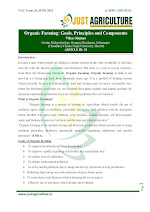Apomixis, derived from two Greek word “APO” (away from) and “MIXIS” (mixing).
Definition:- “Apomixis is a type of reproduction in which sexual organs of related structures take part but seeds are formed without union of gametes.”
OR
“Apomixis is a form of asexual reproduction that occurs via seeds, in which embryos develop without fertilization.”
In apomictic species, sexual reproduction is either suppressed or absent. When sexual reproduction also occurs, the apomixes is termed as Facultative Apomixis. But when sexual reproduction is absent, it is referred to as Obligate Apomixis.
Classification of Apomixis
1. Recurrent Apomixis:
In this type of apomixis, the embryo sac develops from the diploid egg mother cell or from some other diploid cells of the embryo sac without fertilization. Because, the egg cell has the normal diploid number of chromosomes, so the embryo subsequently develops from egg nucleus without fertilization will be also haploid. This type of apomixis occur in some species of cresips, Poa Taraxacum and Allium etc.
2. Non-Recurrent Apomixis:
In this type of apomixis, the embryo develops directly from the haploid egg cell or some other haploid cells of embryo sac without fertilization, so the embryo developed is also haploid. This type of apomixis occurs very rarely and is useful for breeding purposes. The plants produced are haploid and sterile. This type of apomixis occurs in Solanum nigrum and Lilium species etc.
3. Adventive Embryony:
In this type of apomixis embryo develops directly from vegetative cells of the ovule, such as nucellus, integument and chalaza. Adventive embryony found in Mango (Mangifera indica) citrus etc.,
4. Apospory:
Some vegetative cells of the ovule develop into unreduced embryo sacs after meiosis. The embryo may develop from egg cell or some other cell of this embryo sac. It is found in some species of Malus, crepis, Ranum culus etc.,
5. Diplospory:
Embryo sac is produced from the megaspore, which may be haploid or more generally diploid. Generally the meiosis is no modified that the megaspore remains diploid. Diplospory leads to parthenogenesis or apogamy.
6. Parthenogenesis:-
Depending upon whether the embryo sac is haploid or diploid, parthenogenesis is termed as haploid or diploid parthenogenesis. Haploid parthenogenesis reported in Solanum nigrum, Nicotiana, Crepis and Maize. Diploid parthenogenesis reported many grasses e.g. Taraxacum.
7. Apogamy:
Synergids or antipodal cells develop into an embryo. Like parthenogenesis, apogamy may be haploid or diploid depending upon the haploid or diploid embryo sac. Diploid apogamy occurs in Alchemilla, Allium etc.
Significance of Apomixis
Significance of apomixis occur in many plant species in nature. The ability of plants to reproduce apomictically has great significance in crop science because of the following reasons:-
- Apomixis provide an opportunity for producing genetically uniform population.
- Apomictic seedlings are useful for producing uniform rootstocks in apple, citrus and Jamun etc.
- Apomictic seedlings are highly uniform and quite healthy in contrast to sexually produced seedlings.
- Apomictic seedlings are helpful for identification during hybridization.
- Apomictic seedlings are suitable for screening viruses, which are not otherwise transmitted through seeds.










0 Comments